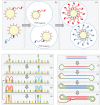Application of next-generation sequencing technologies in virology
- PMID: 22647373
- PMCID: PMC3709572
- DOI: 10.1099/vir.0.043182-0
Application of next-generation sequencing technologies in virology
Abstract
The progress of science is punctuated by the advent of revolutionary technologies that provide new ways and scales to formulate scientific questions and advance knowledge. Following on from electron microscopy, cell culture and PCR, next-generation sequencing is one of these methodologies that is now changing the way that we understand viruses, particularly in the areas of genome sequencing, evolution, ecology, discovery and transcriptomics. Possibilities for these methodologies are only limited by our scientific imagination and, to some extent, by their cost, which has restricted their use to relatively small numbers of samples. Challenges remain, including the storage and analysis of the large amounts of data generated. As the chemistries employed mature, costs will decrease. In addition, improved methods for analysis will become available, opening yet further applications in virology including routine diagnostic work on individuals, and new understanding of the interaction between viral and host transcriptomes. An exciting era of viral exploration has begun, and will set us new challenges to understand the role of newly discovered viral diversity in both disease and health.
Figures






References
-
- Anonymous (2003). Acute respiratory syndrome. China, Hong Kong Special Administrative Region of China, and Viet Nam. Wkly Epidemiol Rec 78, 73–74 - PubMed
-
- Anonymous (2012). ENHanCEd Infectious Diseases (eid2) database. http://www.zoonosis.ac.uk/EID2/, 20 April 2012.
-
- Baillie G. J., Galiano M., Agapow P. M., Myers R., Chiam R., Gall A., Palser A. L., Watson S. J., Hedge J. & other authors (2012). Evolutionary dynamics of local pandemic H1N1/2009 influenza virus lineages revealed by whole-genome analysis. J Virol 86, 11–18 10.1128/JVI.05347-11 - DOI - PMC - PubMed
Publication types
MeSH terms
Grants and funding
LinkOut - more resources
Full Text Sources
Other Literature Sources
Research Materials

